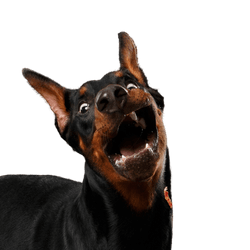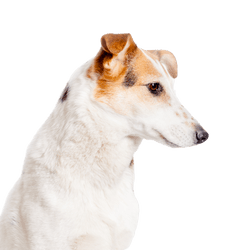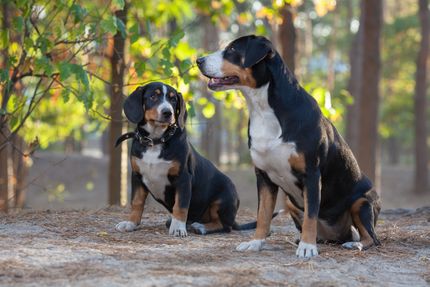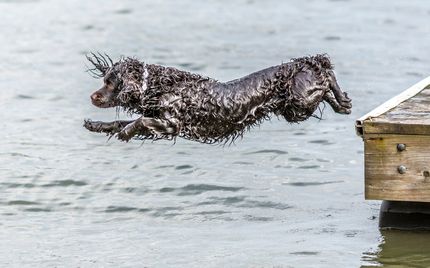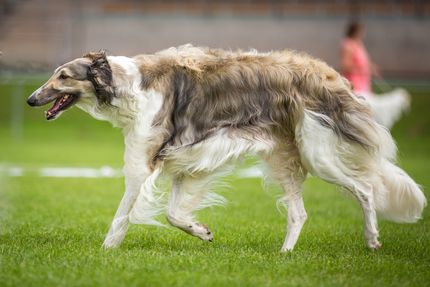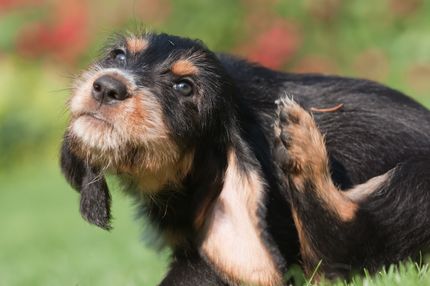Facts & Origin
The Doberman Collie - Doberman and Collie mix
The Doberman Collie is a remarkable cross between a Doberman and a Collie. As a designer dog owner, you can expect your Doberman Collie to combine the best of both breeds.
The Doberman Collie is a loving, intelligent and protective companion. With proper training, socialization and care, this breed mix can be a wonderful family member. His loyalty and protective instincts, coupled with his intelligence and playfulness, make him an especially delightful companion.
| Alternate Name | - |
| Origin | Germany - Scotland |
| Life expectancy | 10 - 14 years |
| Care requirements | low-maintenance |
| Activity level | average - average to high |
| FCI group | not recognised |
| AKC group | not recognised |
| KC group | not recognised |
More Doberman mixes
More Shorthaired collie mixes
Attitude, character and temperament of the breed
Character and Temperament of the Doberman Collie
The Doberman Collie is known for its intelligence, loyalty and strong protective instincts. These dogs are extremely smart, which makes training them relatively easy. They inherit the Doberman's willingness to work and the Collie's energy and playfulness.
This mix is friendly and social, but they can also be alert, which makes them an excellent watchdog. They are family oriented and love to spend time with their humans, whether playing or just relaxing.
Character
Usage
Care and health of the Doberman Collie
The Doberman Collie needs regular physical and mental stimulation. Daily walks, playtime, and obedience training are important to keep their minds sharp and their bodies fit.
In terms of grooming, the Doberman Collie's coat is moderately low maintenance. It should be brushed several times a week to reduce matting and dandruff.
Potential health concerns for the Doberman Collie include hip and elbow dysplasia, progressive retinal atrophy, thyroid problems, and Wobbler syndrome. Regular vet visits and proper nutrition are critical to maintaining your Doberman Collie's health.
What does this mongrel look like?
In terms of size, the Doberman Collie falls into the large dog category and can grow between 55 and 68 inches tall, with a weight of about 30 to 40 kilograms. Specific physical characteristics can vary, but often these dogs have the elegant, streamlined appearance of the Doberman and the dense, fluffy coat of the Collie.
Coat color can vary, depending on dominant genes and can range from black, brown and blue, to fawn, red and white. They also often have distinctive markings on their face, chest and paws.
| Fur length | short - long |
| Fur | flat coated |
| Ear shape | Floppy Ear - Standing Ears |
| Tail | lang - fanned out |
| Anatomy | strong, sporty, square, sporty |
| Size ♀ | 51 - 68 cm |
| Weight ♀ | 21 - 45 kg |
| Size ♂ | 56 - 72 cm |
| Weight ♂ | 25 - 35 kg |
| Suitable For | - |
Known Diseases
Hypothyroidism
Hypothyroidism is a condition in dogs where the thyroid gland does not produce enough thyroid hormones. This can lead to a slowed metabolic rate, weight gain, fatigue, hair loss and other symptoms.
Hip dysplasia (HD)
Hip dysplasia (HD) is a genetic condition in dogs where the hip joint is not shaped properly. This leads to pain, stiffness and restricted movement.
Wobbler syndrome
In veterinary medicine, this is the name given to a complex of symptoms caused by nerve damage in the area of the spinal cord or spinal cord nerves in the area of the cervical spine.
Blue Doberman Syndrome
Blue Doberman Syndrome (Alopecia). This is a hereditary disease that leads to progressive hair loss.
Dancing Doberman Diseas
Initially, there is only bending of the legs, which is caused by muscle failure. In the advanced stage, the disease then leads to paralysis.
Ataxia
Ataxia (from Greek ἀταξία ataxia 'disorder' 'irregularity') is a generic term in medicine for various disorders of movement coordination. Ataxia can occur even when there is no paralysis (paresis), that is, when there is normal muscle strength.
Heart disease
Can occur frequently in dogs and can sometimes be treated with medication.
MDR1 defect
The MDR1 defect is a defect in the MDR1 gene that can occur in some breeds of dogs and in humans. This results in the deficient or absent synthesis of a certain protein which is an important component of the blood-brain barrier, leading to hypersensitivity to some drugs.
Eye diseases
Often occur with allergies and intolerances.
Metabolic diseases (cystinuria)
Cystinuria is a hereditary metabolic disease. Affected dogs lack a transport protein for certain amino acids (protein building blocks). In the kidney, the task of this transport protein is a return transport of amino acids from the urine into the bloodstream.
FAQ
-
The average size of a Doberman-Collie mix is between 55 and 68 inches tall, depending on the size of the parent breeds.
-
Doberman Collies tend to have a smooth or slightly clinging coat that is generally dark brown, black, tan or blue.
-
Doberman Collies are usually smart, loyal, alert and affectionate, as well as very energetic. They are very active and need regular physical and mental stimulation.
-
They have an average life expectancy of 12 to 14 years.
-
They are very energetic dogs and therefore need a lot of exercise. They need at least half an hour a day in the fresh air.
